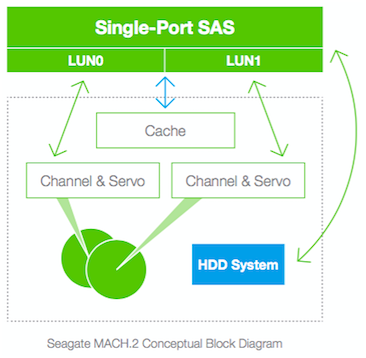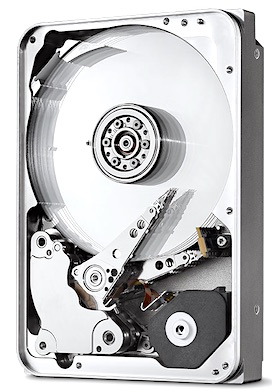München, Starnberg, 05. Dez. 2019 - Festplatten-Datendurchsatz nahezu verdoppelt bei Erhöhung der verfügbaren Speicherkapazität pro Steckplatz im Rechenzentrum...
Zum Hintergrund: aktuelle Festplatten verwenden einen einzelnen Aktuator**, um I/Os vom Gerät zum Host über einen Lese-/Schreibkanal zu übertragen. Dies führt zu einer fixen Leistung, unabhängig von der Kapazitätssteigerung und der Anzahl der Köpfe/Medien pro Laufwerk. Die Seagate MACH.2-Technologie adressiert diese IOPS/TB-Herausforderung mittels zwei Aktuatoren im Laufwerk, die I/Os unabhängig voneinander innerhalb der Festplatte nach außen übertragen können. Damit entsteht eine Parallelität, die es ermöglicht, die Durchsatzleistung zu verdoppeln (**ein Aktuator, engl. actuator = Stellglied, ist eine elektronische Vorrichtung, die von einem Motor gesteuert wird, der den Arm des Festplattenkopfes bewegt).
Innerhalb eines Laufwerks wird die obere Hälfte der Köpfe/Medien dazu von einem Aktuator und die untere Hälfte der Köpfe/Medien von einem zweiten Aktuator bedient. Anmerkung: Wo ein Vorteil, da oft auch ein Nachteil... Bislang ist laut Seagate keine SAS-Version mit Dual-Ports (s.a. Abb. unten) für höhere Ausfallsicherheit bzw. Failover-Szenarien verfügbar und die Kapazität pro Drive ist geringer, weil bauart-bedingt eine Scheibe (disk) weniger zum Einsatz kommt (8 anstelle von 9 disks = 14TB versus 16TB). Anwendungen wie Content Delivery Networks, Video-Streaming, Mailserver, Backup, Hadoop, Cloud-Anwendungen etc. profitieren laut Entwickler von der Dual-Actuator-Technologie; dies ergaben diverse Testsverfahren.
Seagates neue Exos 2X14 Enterprise-Festplatte mit der MACH.2 Dual-Actuator-Technologie wird laut Hersteller von Microsoft für die Anwendung in (Hyperscale-) Rechenzentren getestet. Das Ziel: Aufrechterhaltung der erforderlichen IOPS-Werte für Microsoft Cloud Services wie Azure und den Microsoft Exchange Online E-Mail-Service. Darüber hinaus soll die Technologie eine Erhöhung der verfügbaren Speicherkapazität pro Steckplatz im Rechenzentrum ermöglichen. Erste Tests haben demnach gezeigt, dass MACH.2 die erwarteten Vorteile für hohe IOPS-Workloads erreicht und den Datendurchsatz nahezu verdoppelt. (1)

Abbildung (Bildquelle: Seagate).
(1) Quelle: Detaillierte Informationen hierzu finden Sie im englischsprachigen Seagate Blogpost von John Paulsen. Nachfolgen ein Auszug (gekürzt) aus dem Orginalblog 'Seagate Exos 2X14 enterprise hard drive features groundbreaking MACH.2 dual-actuator technology':
"Seagate’s new Exos 2X14 enterprise hard drive is the first to integrate Seagate’s groundbreaking MACH.2™ multi-actuator technology, and is being tested by customers now for data center deployments. MACH.2 has demonstrated its benefits over single-actuator drives for many applications including content delivery networks (CDNs), video streaming, mail servers, backup/shuttle services, Hadoop, cloud applications, and more.
Microsoft is anticipating great success with Seagate’s Exos 2X14 enterprise hard drives with MACH.2 technology. The goal: maintain the IOPS required for some of Microsoft’s cloud services including Azure and the Microsoft Exchange Online email service, while increasing available storage capacity per data-center slot. With early tests completed, MACH.2 has demonstrated that it achieves the anticipated benefits for high-IOPS workloads.
Microsoft tests Seagate Exos 2X14 with MACH.2 dual-actuator technology
Microsoft has completed its initial round of functional deployment testing of the Exos 2X14, including full infrastructure testing for interoperability and compatibility with the data center infrastructure, product robustness, reliability and ease of integration with its Project Olympus system architecture — as well as the tests on the performance increase MACH.2 provides, which is the key advantage IT architects are looking for.
Microsoft partner architect Aaron Ogus has worked directly with Seagate from the time our MACH.2 technology was in early development, with an eye to deploy the technology for the Microsoft Cloud space. “We did a lot of early testing on Exos 2X14 engineering development units and have now tested out Seagate’s Exos 2X14 CTUs (early production customer test units), and based upon that analysis we’ve found we are getting close to twice the throughput and IOPS, which are the improvements we expected to achieve with the MACH.2 technology,” says Ogus.
To evaluate the capabilities of the MACH.2 drives, Microsoft has been using proven tools such as its Microsoft Exchange Server Jetstress tool, which simulates Exchange 2013 and Exchange 2016 disk I/O load on a server to verify the performance and stability of a disk subsystem. Microsoft has tested sequential throughput (simulating backup operations or streaming) and random read IOPS testing (simulating hyperscale and CDN workloads) among others.
MACH.2 solves cloud data center needs like IOPS-per-terabyte and cost-per-terabyte
Cloud customers deploy large fleets of 3.5-inch HDDs in their data centers and manage their application storage nodes across multiple devices, spread across multiple racks. In order to meet their Service Level Agreements (SLAs), these cloud customers need to achieve a certain level of performance, measured in IOPS (I/Os per second) and command latency, across the deployed HDD storage capacity. This required performance is characterized as IOPS-per-terabyte (IOPS/TB) at a particular latency.
Data center architects also look at enterprise SSDs as one way to provide high IOPS.
That can make sense depending on the balance of various needs for each application including capacity requirements, IOPS, throughput, environmental costs like cooling, and cost. But with their lower cost-per-terabyte and higher capacities, hard drives provide the most effective storage tier for leveraging capacity — if the HDDs can provide the necessary IOPS.
Seagate MACH.2 technology addresses the IOPS/TB challenge by using two actuators that can transfer IOs independent of each other within a single HDD, creating parallelism within a single hard drive that enables up to double the performance. Within a drive, the top half of the read/write heads are addressed by one actuator, while the bottom half of the heads are addressed by a second actuator. Each actuator addresses one half the total capacity of the drive.
How MACH.2 benefits Microsoft’s Exchange server architecture
MACH.2 drives will be deployed in support all of Microsoft’s CSP services including Azure and Exchange — the breadth of applications sharing floor space means it's at a premium. Microsoft wants to minimize slot costs, which is a function of floor space, power, and cooling among other things. When a customer finds IOPS trending down on the types of drives installed, they have to look at other avenues such as adding dual-actuator hard drives.
MACH.2 prevents “stranded capacity”
As long as a particular HDD device meets or exceeds the threshold IOPS/TB as required by the customer, all of the capacity on the HDD device can be utilized. If the IOPS/TB on an HDD drops below a defined threshold based on application workloads, the customer cannot utilize all of the drive capacity with the targeted workload — a problem known as “stranded capacity.” James Borden, cloud product manager at Seagate, explains the dilemma posed by stranded capacity.
“As hard drives get increasingly higher in capacity, up until now the ability to transfer data faster has not advanced commensurately,” says Borden. “Without multi-actuator technology, once you exceed a certain capacity you’re no longer able to deliver the expected quality of service, because you're limited by each drive’s maximum throughput.” “For example, in order to maintain the expected quality of service, a 16TB drive requires twice the maximum throughput capability of an 8TB drive. As your application starts to exceed the maximum IOPS capability of a storage device, the only way to solve that is to put less data on the device — and that equates to stranded capacity.”

Abb. 2: Seagate Multi-Actuator Laufwerkstechnologie (Bildquelle: Seagate).
